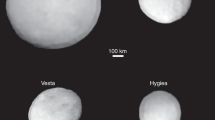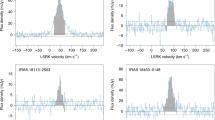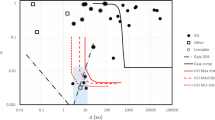Abstract
While collisional families are common in the asteroid belt, only one is known in the Kuiper belt, linked to the dwarf planet Haumea. The characterization of Haumea’s family helps to constrain its origin and, more generally, the collisional history of the Kuiper belt. However, the size distribution of the Haumea family is difficult to constrain from the known sample, which is affected by discovery biases. Here, we use the Outer Solar System Origins Survey (OSSOS) Ensemble to look for Haumea family members. In this OSSOS XVI study we report the detection of three candidates with small ejection velocities relative to the family formation centre. The largest discovery, 2013 UQ15, is conclusively a Haumea family member, with a low ejection velocity and neutral surface colours. Although the OSSOS Ensemble is sensitive to Haumea family members to a limiting absolute magnitude (Hr) of 9.5 (inferred diameter of ~90 km), the smallest candidate is significantly larger, Hr = 7.9. The Haumea family members larger than ≃20 km in diameter must be characterized by a shallow H-distribution slope in order to produce only these three large detections. This shallow size distribution suggests that the family formed in a graze-and-merge scenario, not a catastrophic collision.
This is a preview of subscription content, access via your institution
Access options
Access Nature and 54 other Nature Portfolio journals
Get Nature+, our best-value online-access subscription
$29.99 / 30 days
cancel any time
Subscribe to this journal
Receive 12 digital issues and online access to articles
$119.00 per year
only $9.92 per issue
Buy this article
- Purchase on Springer Link
- Instant access to full article PDF
Prices may be subject to local taxes which are calculated during checkout



Similar content being viewed by others
Data availability
The data that support the plots within this paper are available from the corresponding author upon reasonable request.
Code availability
The survey simulator is available publicly from the OSSOS webpages: http://www.ossos-survey.org/simulator.html. A detailed description of usage is available29.
References
Brown, M. E., Barkume, K. M., Ragozzine, D. & Schaller, E. L. A collisional family of icy objects in the Kuiper belt. Nature 446, 294–296 (2007).
Ragozzine, D. & Brown, M. E. Candidate members and age estimate of the family of Kuiper belt object 2003 EL61. Astron. J. 134, 2160–2167 (2007).
Rabinowitz, D. L., Schaefer, B. E., Schaefer, M. & Tourtellotte, S. W. The youthful appearance of the 2003 EL61 collisional family. Astron. J. 136, 1502–1509 (2008).
Carry, B., Snodgrass, C., Lacerda, P., Hainaut, O. & Dumas, C. Characterisation of candidate members of (136108) Haumea’s family. II. Follow-up observations. Astron. Astrophys. 544, A137 (2012).
Volk, K. & Malhotra, R. The effect of orbital evolution on the Haumea (2003 EL61) collisional family. Icarus 221, 106–115 (2012).
Parker, A. et al. The size distributions of asteroid families in the SDSS Moving Object Catalog 4. Icarus 198, 138–155 (2008).
Proudfoot, B. & Ragozzine, D. A. Modeling the formation of the collisional family of the dwarf planet Haumea. Astron. J. 157, 230 (2019).
Schlichting, H. E. & Sari, R. The creation of Haumea’s collisional family. Astrophys. J. 700, 1242–1246 (2009).
Leinhardt, Z. M., Marcus, R. A. & Stewart, S. T. The formation of the collisional family around the dwarf planet Haumea. Astrophys. J. 714, 1789–1799 (2010).
Fraser, W. C. & Kavelaars, J. J. The size distribution of Kuiper belt objects for D ≥ 10 km. Astron. J. 137, 72–82 (2009).
Dohnanyi, J. S. Collisional model of asteroids and their debris. J. Geophys. Res. 74, 2531–2554 (1969).
Bannister, M. T. et al. OSSOS. VII. 800+ trans-Neptunian objects—the complete data release. Astrophys. J. Suppl. Ser. 236, 18 (2018).
Petit, J.-M. et al. The Canada-France Ecliptic Plane Survey—full data release: the orbital structure of the Kuiper belt. Astron. J. 142, 131 (2011).
Petit, J.-M. et al. The Canada-France Ecliptic Plane Survey (CFEPS)—high-latitude component. Astron. J. 153, 236 (2017).
Alexandersen, M. et al. A carefully characterized and tracked trans-Neptunian survey: the size distribution of the plutinos and the number of Neptunian trojans. Astron. J. 152, 111 (2016).
Rein, H. & Liu, S.-F. REBOUND: an open-source multi-purpose N-body code for collisional dynamics. Astron. Astrophys. 537, A128 (2012).
Pike, R. E. et al. Col-OSSOS: z-Band photometry reveals three distinct TNO surface types. Astron. J. 154, 101 (2017).
Schwamb, M. E. et al. Col-OSSOS: the Colors of the Outer Solar System Origins Survey. Astrophys. J. Suppl. Ser. 243, 12 (2019).
Anderson, T. W. & Darling, D. A. A test of goodness of fit. J. Am. Stat. Assoc. 49, 765–769 (1954).
Lawler, S. M. et al. OSSOS. VIII. The transition between two size distribution slopes in the scattering disk. Astron. J. 155, 197 (2018).
Fraser, W. C., Brown, M. E., Morbidelli, A., Parker, A. & Batygin, K. The absolute magnitude distribution of Kuiper belt objects. Astrophys. J. 782, 100 (2014).
Vilenius, E. et al. TNOs are Cool: a survey of the trans-Neptunian region. XIV. Size/albedo characterization of the Haumea family observed with Herschel and Spitzer. Astron. Astrophys. 618, A136 (2018).
Petit, J.-M., Kavelaars, J. J., Gladman, B. & Loredo, T. in The Solar System Beyond Neptune (eds Barucci, M. A. et al.) 71–87 (University of Arizona Press, 2008).
Lykawka, P. S., Horner, J., Mukai, T. & Nakamura, A. M. The dynamical evolution of dwarf planet (136108) Haumea’s collisional family: general properties and implications for the trans-Neptunian belt. Mon. Not. R. Astron. Soc. 421, 1331–1350 (2012).
Ivezic, Z. et al. Large Synoptic Survey Telescope: from science drivers to reference design. Serb. Astron. J. 176, 1–13 (2008).
Ortiz, J. L. et al. Rotational fission of trans-Neptunian objects: the case of Haumea. Mon. Not. R. Astron. Soc. 419, 2315–2324 (2012).
Campo Bagatin, A., Benavidez, P. G., Ortiz, J. L. & Gil-Hutton, R. On the genesis of the Haumea system. Mon. Not. R. Astron. Soc. 461, 2060–2067 (2016).
Leinhardt, Z. M. & Stewart, S. T. Collisions between gravity-dominated bodies. I. Outcome regimes and scaling laws. Astrophys. J. 745, 79 (2012).
Lawler, S. M. et al. OSSOS: X. How to use a survey simulator: statistical testing of dynamical models against the real Kuiper belt. Front. Astron. Space Sci. 5, 14 (2018).
Shankman, C., Gladman, B. J., Kaib, N., Kavelaars, J. J. & Petit, J. M. A possible divot in the size distribution of the Kuiper belt’s scattering objects. Astro. J. Lett. 764, L2 (2013).
Vilenius, E. et al. ‘TNOs are Cool’: a survey of the trans-Neptunian region. X. Analysis of classical Kuiper belt objects from Herschel and Spitzer observations. Astron. Astrophys. 564, A35 (2014).
Ortiz, J. L. et al. The size, shape, density and ring of the dwarf planet Haumea from a stellar occultation. Nature 550, 219–223 (2017).
Müller, T. et al. Haumea’s thermal emission revisited in the light of the occultation results. Icarus https://doi.org/10.1016/j.icarus.2018.11.011 (2019).
Fornasier, S. et al. TNOs are Cool: A survey of the trans-Neptunian region. VIII. Combined Herschel PACS and Spire observations of nine bright targets at 70–500 μm. Astron. Astrophys. 555, A15 (2013).
Elliot, J. L. et al. Size and albedo of Kuiper belt object 55636 from a stellar occultation. Nature 465, 897–900 (2010).
Lellouch, E. et al. ‘TNOs are Cool’: A survey of the trans-Neptunian region. IX. Thermal properties of Kuiper belt objects and centaurs from combined Herschel and Spitzer observations. Astron. Astrophys. 557, A60 (2013).
Holmberg, J., Flynn, C. & Portinari, L. The colours of the Sun. Mon. Not. R. Astron. Soc. 367, 449–453 (2006).
Denneau, L. et al. The Pan-STARRS Moving Object Processing System. Publ. Astron. Soc. Pac. 125, 357 (2013).
Magnier, E. A. et al. The Pan-STARRS 1 photometric reference ladder, release 12.01. Astrophys. J. Suppl. Ser. 205, 20 (2013).
Lin, H. W. et al. The Pan-STARRS 1 discoveries of five new Neptune trojans. Astron. J. 152, 147 (2016).
Acknowledgements
This work is based on observations obtained with MegaPrime/MegaCam, a joint project of CFHT and CEA/DAPNIA, at the Canada–France–Hawaii Telescope (CFHT) that is operated by the National Research Council (NRC) of Canada, the Institut National des Sciences de l’Univers of the Centre National de la Recherche Scientifique of France and the University of Hawaii. We recognize and acknowledge the very significant cultural role of the summit of Maunakea. We are most fortunate to have the opportunity to conduct observations from this mountain. B.C.N.P., D.R. and S.M. acknowledge support from a BYU Mentored Environment Grant.
Author information
Authors and Affiliations
Contributions
R.E.P. tested the models using the survey simulator, determined the mass and population estimate, and wrote most of the paper draft. B.C.N.P. generated the orbital distribution models used, and S.M., D.R. and B.C.N.P. classified the objects as Haumea family member candidates. M.A. assisted with the mass estimate and generating the approximate Pan-STARRS1 survey simulator blocks. M.A., M.T.B., Y.-T.C., B.J.G., J.J.K., S.G. and K.V. did the object detections and survey characterization for the OSSOS survey.
Corresponding author
Ethics declarations
Competing interests
The authors declare no competing interests.
Additional information
Publisher’s note: Springer Nature remains neutral with regard to jurisdictional claims in published maps and institutional affiliations.
Rights and permissions
About this article
Cite this article
Pike, R.E., Proudfoot, B.C.N., Ragozzine, D. et al. A dearth of small members in the Haumea family revealed by OSSOS. Nat Astron 4, 89–96 (2020). https://doi.org/10.1038/s41550-019-0867-z
Received:
Accepted:
Published:
Issue Date:
DOI: https://doi.org/10.1038/s41550-019-0867-z
This article is cited by
-
The formation of Haumea and its family via binary merging
Nature Communications (2022)



